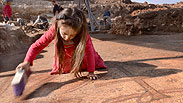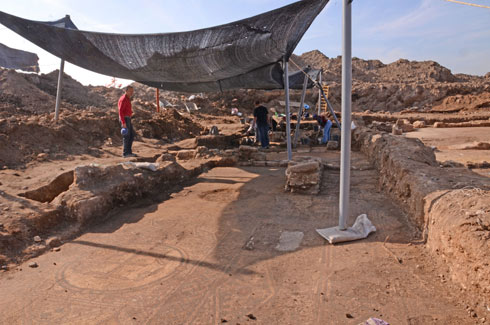An archeology excavation mission being conducted in southern Israel revealed an impressive and yet unknown church covered with a breathtaking Byzantine mosaic.
The Israel Antiquities Authority (IAA) discovery Wednesday near the Haredi community of Aluma near Kiryat Gat took place in wake of the prior discovery of the ruins of the infrastructure of what is believed to be an ancient city.
Archeologists believe the church served as a main altar for Christian ritual sacrifice roughly 1,500 years ago. In addition to the church and mosaic, archeologists also found five written engravings.
Related stories:
- Church of Nativity undergoes facelift
- Turkey to open first sea tunnel to ever link two continents
- Rare golden treasure found in Jerusalem
The dig is being run by Dr. Daniel Varga and Dr. David Dagan. According to Varga, they unearthed an impressive basilica building, 22 meters long and 12 meters wide. The structure is divided into a central hall and two side halls partitioned by marble columns. At the front of the structure there is an open courtyard (atrium) covered with a white mosaic, including a well.
"From the courtyard you enter into a rectangular hall (narthex) covered with a delicate mosaic adorned with geometrical patterns, and in the center, across from the central hall, there is a 12-line inscription in Greek in which Jesus and Maria, as well as a donor for the mosaic, are mentioned," Varga said.
The dig also revealed a potter workshop and in it cooking pots, jugs, bowls and a wide array of candles were found. Also, classic Byzantine-era glasswork was unearthed. According to the archeologists, all these point to a highly developed local culture.
The church is part of a large Byzantine town that was located along the road connecting Ashkelon and Beit Guvrin and Jerusalem. Excavation work by the IAA along the road has in the past unearthed villages from the same historical period.
However, no churches had as of now been found in the area. Israel's Byzantine period is dated 330-638 CE. Other archaeological findings from the period in Israel include a church in Jerusalem, a small concealed street in Jerusalem and a wine press from 1,400 years ago.















_wa.jpg)



